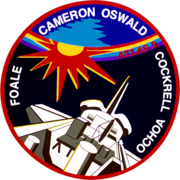STS-56

ATLAS-2 in Discovery's payload bay
|
|||||
| Mission type | Scientific | ||||
|---|---|---|---|---|---|
| Operator | NASA | ||||
| COSPAR ID | 1993-023A | ||||
| SATCAT № | 22621 | ||||
| Mission duration | 9 days, 06 hours, 08 minutes, 24 seconds | ||||
| Distance travelled | 6,202,407 kilometers (3,853,997 mi) | ||||
| Orbits completed | 148 | ||||
| Spacecraft properties | |||||
| Spacecraft | Space Shuttle Discovery | ||||
| Landing mass | 93,683 kilograms (206,536 lb) | ||||
| Payload mass | 7,026 kilograms (15,490 lb) | ||||
| Crew | |||||
| Crew size | 5 | ||||
| Members |
Kenneth D. Cameron Stephen S. Oswald C. Michael Foale Kenneth D. Cockrell Ellen Ochoa |
||||
| Start of mission | |||||
| Launch date | 8 April 1993, 05:29:00 UTC | ||||
| Launch site | Kennedy LC-39B | ||||
| End of mission | |||||
| Landing date | 17 April 1993, 11:37:19 UTC | ||||
| Landing site | Kennedy SLF Runway 33 | ||||
| Orbital parameters | |||||
| Reference system | Geocentric | ||||
| Regime | Low Earth | ||||
| Perigee | 291 kilometres (181 mi) | ||||
| Apogee | 299 kilometres (186 mi) | ||||
| Inclination | 57.0 degrees | ||||
| Period | 90.4 min | ||||
|
|
|||||


Left to right - Seated: Oswald, Cameron; Standing: Cockrell, Foale, Ochoa
STS-56 was a Space Shuttle Discovery mission to perform special experiments. The mission was launched from Kennedy Space Center, Florida, on 8 April 1993.
The primary payload of the flight was the Atmospheric Laboratory for Applications and Science-2 (ATLAS-2), designed to collect data on the relationship between the sun's energy output and Earth's middle atmosphere and how these factors affect the ozone layer. It included six instruments mounted on a Spacelab pallet in the cargo bay, with the seventh mounted on the wall of the bay in two Get Away Special canisters. Atmospheric instruments included the Atmospheric Trace Molecule Spectroscopy (ATMOS) experiment, the Millimeter Wave Atmospheric Sounder (MAS), and the Shuttle Solar Backscatter Ultraviolet/A (SSBUV/A) spectrometer (on the cargo bay wall). Solar science instruments were the Solar Spectrum Measurement (SOLSPEC) instrument, the Solar Ultraviolet Irradiance Monitor (SUSIM), and the Active Cavity Radiometer (ACR) and Solar Constant (SOLCON) experiments.
ATLAS-2 is one element of NASA's Mission to Planet Earth program. All seven ATLAS-2 instruments first flew on ATLAS-1 during STS-45, and flew a third time in late 1994 on STS-66.
On 11 April, the crew used the remote manipulator arm to deploy the Shuttle Point Autonomous Research Tool for Astronomy-201 (SPARTAN-201), a free-flying science instrument platform designed to study velocity and acceleration of the solar wind and observe the sun's corona. Collected data was stored on tape for playback after return to Earth. SPARTAN-201 was retrieved on 13 April.
...
Wikipedia
